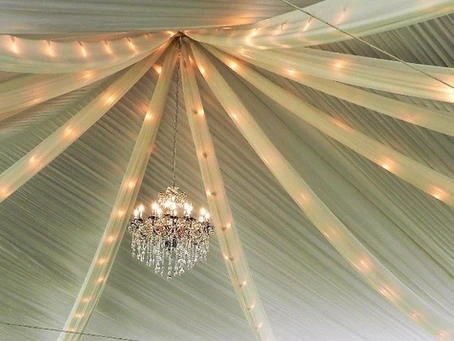Making a decorative impression on a large space in a venue or tent can be difficult and expensive. The use of lights, hard props, and florals are all a great trick to accomplish what is needed and indeed it will take a mixture of these. But one of the easiest (I’m sure that is debatable) and cost effective (may also be debatable) is the use of loose fabric.
Fabric can be used to hide certain areas such as ceilings and transform them into billowing folds of beauty. And you can also use fabric to enhance certain areas such as a bridal table or buffet. And a great use of fabric is separation of certain areas into intimate settings. Fabric can also be used to create grandeur such as sweeping ceilings or even sharp edges and shapes with the use of such fabrics as spandex.
I do want to give you a few tips if you are new to draping. The most important is to roll the edges when you are working with bulk fabric. This is done by taking the edges of the fabric when installing and folding about 2-3 inches inward… that way the edges of the fabric don’t show. It is also best to overlap the fabric when using multiple panels… such as in a ceiling install. Finger pleating is the install we usually use. That is done by folding the fabric about a fingers length and making a pleat. This can be done in a flat install or a bunch install. I highly recommend using finger pleats for all installs.
It sounds simple… but I always cut my fabric a bit longer than needed… then trim it afterwards. Many a times I have cut fabric short rendering it useless. Extra fabric can always be bunched into a rosette at the junction… a really elegant look. Don’t skimp!
One more quick tip and we will get on with a concept. When installing multiple layers be sure to get them even. This is fairly easily done. Fabric is very very forgiving.
Adjustments can be made even after install. A simple staple or ziptie can make an easy adjustment. And adjustments can be made to a whole panel or even just to a part of the panel. Experiment for your best look.
Another concept I would like to introduce is layers – layers of the same fabric, layers of different colors and fabrics, layers of fabric and lights. Layers add depth and texture and richness. That layer can be in the form of swoops of different heights, direction, or color. Contrasting colors can work… but I like to use complimentary colors or even just a bit offshade. Layers of textures can also be effective… such as a semi sheer under drape with an overlay swoop of burlap. I use a semi sheer Harmony material as my base.
That layer can also be b-lights for a starburst twinkle effect or even stringlights such as café lights.
We can add texture and look to a base such as tent liner using a colorful Shanghai Silk.
And I want to leave you with just a few invaluable tips learned over the years of trial and error:
- Pleat and stretch fabric and hold with zipties on legs… do not twist… always straight lines.
- You may find very useful spring clips at Office Depot…. Great for holding panels together and taking up unruly pleats.
- Extra length can be made into rosettes at the end of a drape or even at any junction.
- Multiple rosettes at a crown can make a bell.
- Fabric can be stretched tight or left in a gentle swoop… but it must be uniform and be sure to match swoops throughout your project.
- Fingerpleat, fingerpleat, fingerpleat.
- Be sure to hide all mechanics (zipties, staples, string or line) with rolls or rosettes or even bands made of extra fabric like a sash.
- Save yourself a headache and always use certified fire retardant fabric. Fire marshals do not usually have a sense of humor.
John Jakob Taylor’s Rental Equipment Co. Fort Worth, TX http://eventurze.blogspot.com

